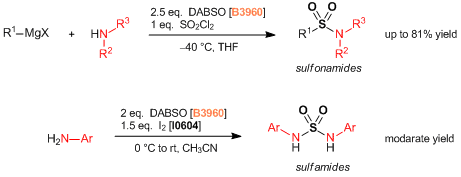Published TCIMAIL newest issue No.200 | Product Document Searching Made Easy by 2D Code! | TCI Chemistry News November 2025 | [Product Highlights] Catechol-containing Methacrylate Monomer for... | Various analytical charts can be searched on each product detail page and Product Document Search (The kinds of analytical charts differ by product)
Maximum quantity allowed is 999
CAS RN: 119752-83-9 | 产品编码: B3960
Bis(sulfur Dioxide)-1,4-diazabicyclo[2.2.2]octane Adduct
![Bis(sulfur Dioxide)-1,4-diazabicyclo[2.2.2]octane Adduct Chemical Structure of Bis(sulfur Dioxide)-1,4-diazabicyclo[2.2.2]octane Adduct](/medias/B3960.jpg?context=bWFzdGVyfHJvb3R8NTkxMTF8aW1hZ2UvanBlZ3xhREZrTDJnMFlTODRPVEl3TVRnd016STJORE13TDBJek9UWXdMbXB3Wnd8MDlhZDVmMDUzNTU2OTI4OGU3MzVjYWFlOWYyYzcyNGYzYzI3NzM0NjQ2ODBhNDI3MzYzOWM3ZDRiZmEzZjRhNw)
| 产品编码 | B3960 |
纯度/分析方法 
|
>94.0%(T) |
| 分子式/分子量 | C__6H__1__2N__2O__4S__2 = 240.29 |
| 外观与形状(20°C) | 固体 |
储存温度 
|
冷藏 (0-10°C) |
| 储存在惰性气体下 | 存放于惰性气体之中 |
| 应避免的情况 | 空气,加热 |
包装和容器 
|
1G-Glass Bottle with Plastic Insert (查看图片) |
| CAS RN | 119752-83-9 |
| Reaxys-RN | 21034099 |
| PubChem物质ID | 354335121 |
| Appearance | White to Almost white powder to crystal |
| Purity(Iodometric back titration) | min. 94.0 % |
| 熔点 | 180 °C(dec.) |
| 水溶性 | 可溶 |
| 象形图 |

|
| 信号词 | Warning |
| 危险性说明 | H315 : Causes skin irritation. H319 : Causes serious eye irritation. |
| 防范说明 | P264 : Wash skin thoroughly after handling. P280 : Wear protective gloves/ eye protection/ face protection. P302 + P352 : IF ON SKIN: Wash with plenty of water. P337 + P313 : If eye irritation persists: Get medical advice/ attention. P305 + P351 + P338 : IF IN EYES: Rinse cautiously with water for several minutes. Remove contact lenses, if present and easy to do. Continue rinsing. P362 + P364 : Take off contaminated clothing and wash it before reuse. P332 + P313 : If skin irritation occurs: Get medical advice/ attention. |
| HS编码* | 2933.59-000 |

-
Used Chemicals
-
- 4-Biphenylboronic Acid (contains varying amounts of Anhydride) [B2294]
- Nickel(II) Bromide Ethylene Glycol Dimethyl Ether Complex (=NiBr2(glyme)) [N1050]
- 3,4,7,8-Tetramethyl-1,10-phenanthroline (= tmphen) [T0847]
- Bis(sulfur Dioxide)-1,4-diazabicyclo[2.2.2]octane Adduct (= DABSO) [B3960]
- Lithium tert-Butoxide (= LiOtBu)
- tert-Butyl Bromoacetate [B1473]
- 1,3-Dimethyl-2-imidazolidinone (= DMI) [D1477]
-
Procedure
-
Under nitrogen atmosphere, a degassed DMI (20 mL) solution of 4-biphenylboronic acid (792 mg, 4.00 mmol), DABSO (577 mg, 2.40 mmol), tmphen (95 mg, 0.40 mmol), lithium tert-butoxide (320 mg, 4.00 mmol) and NiBr2(glyme) (123 mg, 0.40 mmol) was stirred at 100 °C for 14 hours. The mixture was cooled to room temperature and tert-butyl bromoacetate (1.17 mL, 8.00 mmol) was added and the reaction mixture stirred for 1 hour. Water (20 mL) was poured into the reaction mixture and the mixture was extracted with diethyl ether (50 mL x 3). The combined organic phase was washed with water (50 mL) and brine (40 mL), dried over sodium sulfate and filtered. The solvent was removed under reduced pressure and the residue was purified by medium pressure preparative chromatography (ethyl acetate:hexane = 5:95 - 15:85 on silica gel) to give compound 1 as a white solid (1.01 g, 76%).
-
Experimenter’s Comments
-
NiBr2(glyme) and LiOtBu were weighed into a sample tube in a glove box because these reagents are moisture sensitive. If these were used in air, it should be weighted quickly and used up the reagents as soon as possible after opening.
Since the ligand of NiBr2(glyme) may be desorbed under reduced pressure, depressurization operations is desirable to be finished as soon as possible.
The reaction mixture was monitored by TLC (ethyl acetate:hexane = 2:1, Rf = 0.38) and UPLC-MS.
-
Analytical Data
-
Compound 1
1H NMR (400 MHz, CDCl3); δ 8.00 (d, 2H, J = 8.9 Hz), 7.78 (m, 2H), 7.58–7.66 (m, 2H), 7.42-7.54 (m, 3H), 4.08 (s, 2H), 1.58 (s, 2H), 1.39 (s, 9H).
-
Lead Reference
-
- Nickel(II)-Catalyzed Synthesis of Sulfinates from Aryl and Heteroaryl Boronic Acids and the Sulfur Dioxide Surrogate DABSO

-
Used Chemicals
-
Procedure
-
To a solution of 4-bromobiphenyl (1.17 g, 5.00 mmol), DABSO (721 mg, 3.00 mmol), and PdCl2(Amphos)2 (177 mg, 0.25 mmol) in anhydrous isopropyl alcohol (20 mL) was added triethylamine (2.1 mL, 15 mmol) at room temperature and the mixture was stirred at 75 °C for 23 hours. The suspension was cooled at room temperature and NFSI (2.36 g, 7.5 mmol) was added and the reaction mixture stirred for 3 hours until completion. The solvent was removed under reduced pressure. The residue was diluted with ethyl acetate (20 mL) and filtrated through celite pad. The filtrate was washed with saturated aqueous Na2S2O3 solution (20 mL) and brine (20 mL), dried over sodium sulfate and filtered. The solvent was removed under reduced pressure and the residue was purified by medium pressure preparative chromatography (ethyl acetate:hexane = 2:98 - 5:95 on silica gel) to give compound 1 as a white solid (928 mg, 79%).
-
Experimenter’s Comments
-
The reaction mixture was monitored by TLC (ethyl acetate:hexane = 1:9, Rf = 0.57) and UPLC-MS.
-
Analytical Data
-
Compound 1
1H NMR (400 MHz, CDCl3); δ 8.12–8.04 (m, 2H), 7.86–7.80 (m, 2H), 7.67–7.58 (m, 2H), 7.44-7.55 (m, 3H).
-
Lead Reference
-
- One-pot palladium-catalyzed synthesis of sulfonyl fluorides from aryl bromides

Reference
- Copper(I)-catalyzed Sulfonylative Suzuki?Miyaura Cross-coupling

Reference
- DABCO- Bis (sulfur dioxide), DABSO, as a Convenient Source of Sulfur Dioxide for Organic Synthesis: Utility in Sulfonamide and Sulfamide Preparations

Reference
- Synthesis of Aromatic Sulfones from SO2 and Organosilanes Under Metal-free Conditions
[产品拾贝] DABSO作为SO2来源用于芳基硼酸的直接磺酰化Suzuki偶联
[TCI应用实例] 使用DABSO和NFSI对芳基溴化物进行一锅法钯催化的氟磺酰化反应
化学品安全说明书(SDS)
如需更多帮助,请联系我 们。
技术规格
CoA及其他文档
示例 CoA
目前没有该产品的 CoA 示例。
分析图谱

很抱歉,您搜索的分析图谱无法提供。


![Thumbnail of Bis(sulfur Dioxide)-1,4-diazabicyclo[2.2.2]octane Adduct](/medias/B3960.jpg?context=bWFzdGVyfHJvb3R8MTc4NjB8aW1hZ2UvanBlZ3xhRFl4TDJnMU1pODRPVE16TmpVNU9ETTJORFEyTDBJek9UWXdMbXB3Wnd8OTQxZDk4MDNkMzdlZjE1Mzg5NTRkOGExMjJmZmU5MDUxNjdlODY0ZmE3ZjZjMTczMGEwYjg2NTdjYWU0ODZhOA)
![Bis(sulfur Dioxide)-1,4-diazabicyclo[2.2.2]octane Adduct Bis(sulfur Dioxide)-1,4-diazabicyclo[2.2.2]octane Adduct](/_ui/responsive/theme-tci/images/missing_product_zoom.webp)


